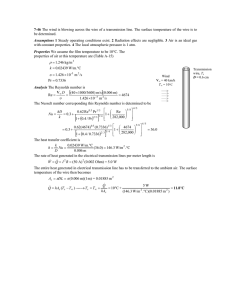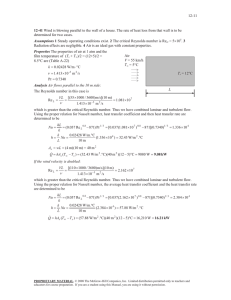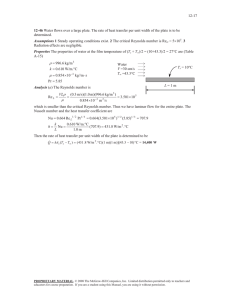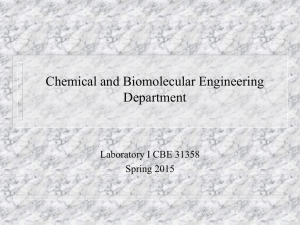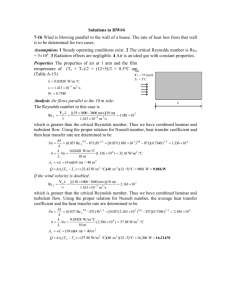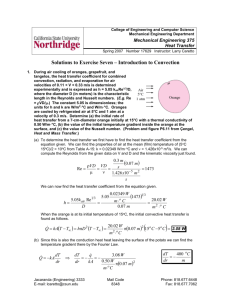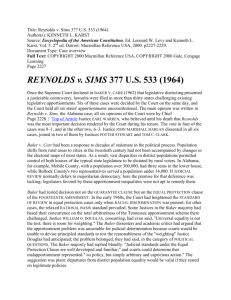Chapter 7 Solutions
advertisement
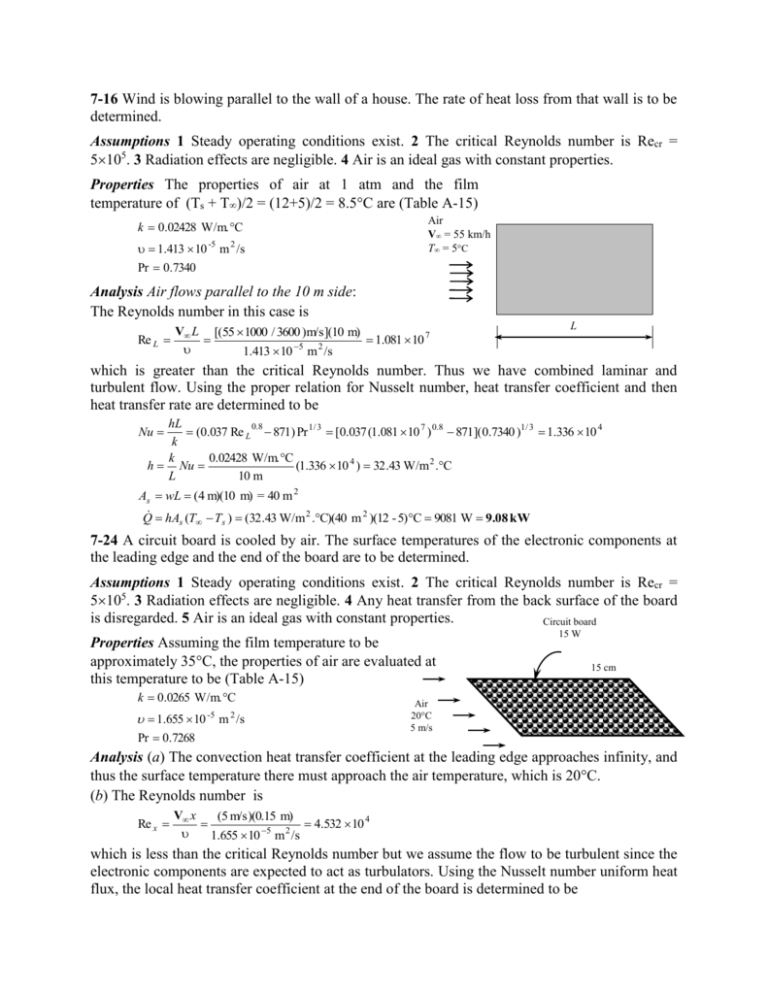
7-16 Wind is blowing parallel to the wall of a house. The rate of heat loss from that wall is to be determined. Assumptions 1 Steady operating conditions exist. 2 The critical Reynolds number is Recr = 5105. 3 Radiation effects are negligible. 4 Air is an ideal gas with constant properties. Properties The properties of air at 1 atm and the film temperature of (Ts + T)/2 = (12+5)/2 = 8.5C are (Table A-15) k 0.02428 W/m. C 1.413 10 -5 m 2 /s Air V = 55 km/h T = 5C Pr 0.7340 Ts = 12C Analysis Air flows parallel to the 10 m side: The Reynolds number in this case is Re L V L [(55 1000 / 3600 )m/s](10 m) 1.081 10 7 1.413 10 5 m 2 /s L which is greater than the critical Reynolds number. Thus we have combined laminar and turbulent flow. Using the proper relation for Nusselt number, heat transfer coefficient and then heat transfer rate are determined to be hL (0.037 Re L 0.8 871) Pr 1 / 3 [0.037 (1.081 10 7 ) 0.8 871]( 0.7340 )1/ 3 1.336 10 4 k k 0.02428 W/m. C h Nu (1.336 10 4 ) 32 .43 W/m 2 .C L 10 m Nu As wL (4 m)(10 m) = 40 m 2 Q hAs (T Ts ) (32 .43 W/m 2 .C)(40 m 2 )(12 - 5) C 9081 W 9.08 kW 7-24 A circuit board is cooled by air. The surface temperatures of the electronic components at the leading edge and the end of the board are to be determined. Assumptions 1 Steady operating conditions exist. 2 The critical Reynolds number is Recr = 5105. 3 Radiation effects are negligible. 4 Any heat transfer from the back surface of the board is disregarded. 5 Air is an ideal gas with constant properties. Circuit board Properties Assuming the film temperature to be approximately 35C, the properties of air are evaluated at this temperature to be (Table A-15) k 0.0265 W/m. C 1.655 10 -5 2 m /s Pr 0.7268 15 W 15 cm Air 20C 5 m/s Analysis (a) The convection heat transfer coefficient at the leading edge approaches infinity, and thus the surface temperature there must approach the air temperature, which is 20C. (b) The Reynolds number is Re x V x (5 m/s)(0.15 m) 4.532 10 4 5 2 1.655 10 m /s which is less than the critical Reynolds number but we assume the flow to be turbulent since the electronic components are expected to act as turbulators. Using the Nusselt number uniform heat flux, the local heat transfer coefficient at the end of the board is determined to be hx x 0.0308 Re x 0.8 Pr 1 / 3 0.0308 (4.532 10 4 ) 0.8 (0.7268 )1 / 3 147 .0 k k 0.02625 W/m. C h x x Nu x (147 .0) 25 .73 W/m 2 .C x 0.15 m Nu x Then the surface temperature at the end of the board becomes q (15 W)/(0.15 m) 2 20 C + 45.9C hx 25 .73 W/m 2 .C q hx (Ts T ) Ts T Discussion The heat flux can also be determined approximately using the relation for isothermal surfaces since the boundary condition matters less for turbulent flow than for laminar, hx x 0.0296 Re x 0.8 Pr1 / 3 0.0296 (45,320 )0.8 (0.7268 )1 / 3 141 .3 k k 0.02625 W/m. C hx x Nu x (141 .3) 24 .73 W/m2 .C x 0.15 m Nu x Then the surface temperature at the end of the board becomes q (15 W)/(0.15 m) 2 20 C + 47.0C hx 24 .73 W/m 2 .C q h x (Ts T ) Ts T Note that the two results are close to each other. 7-46 The wind is blowing across the wire of a transmission line. The surface temperature of the wire is to be determined. Assumptions 1 Steady operating conditions exist. 2 Radiation effects are negligible. 3 Air is an ideal gas with constant properties. 4 The local atmospheric pressure is 1 atm. Properties We assume the film temperature to be 10C. The properties of air at this temperature are (Table A-15) 1.246 kg/m 3 k 0.02439 W/m. C Wind V = 40 km/h T = 10C 1.426 10 -5 m 2 /s Pr 0.7336 Analysis The Reynolds number is Re V D (40 100 0/3600) 1.426 10 m/s (0.006 m) 5 m 2 /s 4674 The Nusselt number corresponding this Reynolds number is determined to be hD 0.62 Re 0.5 Pr 1 / 3 Nu 0.3 1/ 4 k 1 0.4 / Pr 2 / 3 Re 5 / 8 1 282 ,000 4/5 5/8 0.62 (4674 ) 0.5 (0.7336 )1 / 3 4674 0.3 1 1/ 4 282 ,000 1 0.4 / 0.7336 2 / 3 4/5 36 .0 The heat transfer coefficient is h k 0.02439 W/m. C Nu (36 .0) 146 .3 W/m2 .C D 0.006 m The rate of heat generated in the electrical transmission lines per meter length is Transmission wire, Ts D = 0.6 cm W Q I 2 R (50 A) 2 (0.002 Ohm) = 5.0 W The entire heat generated in electrical transmission line has to be transferred to the ambient air. The surface temperature of the wire then becomes As DL (0.006 m)(1m) = 0.01885m 2 Q 5W Q hAs (Ts T ) Ts T 10 C + 11.8C 2 hAs (146 .3 W/m .C)(0.01885 m 2 )
